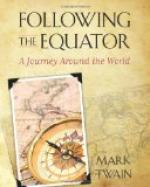Dunedin, same date. The town justifies Michael Davitt’s praises. The people are Scotch. They stopped here on their way from home to heaven-thinking they had arrived. The population is stated at 40,000, by Malcolm Ross, journalist; stated by an M. P. at 60,000. A journalist cannot lie.
To the residence of Dr. Hockin. He has a fine collection of books relating to New Zealand; and his house is a museum of Maori art and antiquities. He has pictures and prints in color of many native chiefs of the past—some of them of note in history. There is nothing of the savage in the faces; nothing could be finer than these men’s features, nothing more intellectual than these faces, nothing more masculine, nothing nobler than their aspect. The aboriginals of Australia and Tasmania looked the savage, but these chiefs looked like Roman patricians. The tattooing in these portraits ought to suggest the savage, of course, but it does not. The designs are so flowing and graceful and beautiful that they are a most satisfactory decoration. It takes but fifteen minutes to get reconciled to the tattooing, and but fifteen more to perceive that it is just the thing. After that, the undecorated European face is unpleasant and ignoble.
Dr. Hockiu gave us a ghastly curiosity—a lignified caterpillar with a plant growing out of the back of its neck—a plant with a slender stem 4 inches high. It happened not by accident, but by design—Nature’s design. This caterpillar was in the act of loyally carrying out a law inflicted upon him by Nature—a law purposely inflicted upon him to get him into trouble—a law which was a trap; in pursuance of this law he made the proper preparations for turning himself into a night-moth; that is to say, he dug a little trench, a little grave, and then stretched himself out in it on his stomach and partially buried himself—then Nature was ready for him. She blew the spores of a peculiar fungus through the air with a purpose. Some of them fell into a crease in the back of the caterpillar’s neck, and began to sprout and grow—for there was soil there—he had not washed his neck. The roots forced themselves down into the worm’s person, and rearward along through its body, sucking up the creature’s juices for sap; the worm slowly died, and turned to wood. And here he was now, a wooden caterpillar, with every detail of his former physique delicately and exactly preserved and perpetuated, and with that stem standing up out of him for his monument—monument commemorative of his own loyalty and of Nature’s unfair return for it.
Nature is always acting like that. Mrs. X. said (of course) that the caterpillar was not conscious and didn’t suffer. She should have known better. No caterpillar can deceive Nature. If this one couldn’t suffer, Nature would have known it and would have hunted up another caterpillar. Not that she would have let this one go, merely because it was defective. No. She would have waited and let him turn into a night-moth; and then fried him in the candle.




